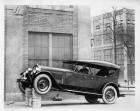|
Re: Valves & seats
|
||||
|---|---|---|---|---|
|
Home away from home
|
Quote:
In the service manual they talk about the angles, 45 and 30, but do not talk about what the seat size/width should be. Maybe they do in a service bulletin somewhere, or maybe they weren't doing 3 angles?
Posted on: Today 14:52
|
|||
|
||||
|
Re: Valves & seats
|
||||
|---|---|---|---|---|
|
Home away from home
|
Some Packard valve guides were larger at the upper end than at the lower end. The pressure in the exhaust port can vary considerably under different operating conditions. Shop manuals are available on this website for most year models.
Posted on: Today 14:55
|
|||
|
||||
|
Re: Valves & seats
|
||||
|---|---|---|---|---|
|
Home away from home
|
I think they gave a spec ... somewhere. In most cases, the valve seat is considerably narrower than the valve face. The narrow contact tends to prevent debris like carbon from sticking to the valve or seat face and it gives a higher pressure contact than a wider seat would.
Posted on: Today 15:00
|
|||
|
||||
|
Re: Valves & seats
|
||||
|---|---|---|---|---|
|
Home away from home
|
Quote:
If Packard gives a spec on seat face size, I haven't been able to find it. Yes, the seat face should be much less than the valve's face for the reasons you mention. Ideally the seat face should land in the middle of the valve face.
Posted on: Today 15:09
|
|||
|
||||
|
Re: Valves & seats
|
||||
|---|---|---|---|---|
|
Home away from home
|
Quote:
What? They use different materials because they run hotter... It might get too hot for a rubber seal to ever work. Seals themselves depend on surface finish, cylindricity, temperature, and lubricant type; little else.
Posted on: Today 15:25
|
|||
|
1955 400 | Registry | Project Blog
1955 Clipper Deluxe | Registry | Project Blog 1955 Clipper Super Panama | Registry Email (Parts/service inquiries only, please. Post all questions on the forum.) service@ultramatic.info |
||||
|
||||
|
Re: Valves & seats
|
||||
|---|---|---|---|---|
|
Home away from home
|
Keep in mind that on an overhead valve engine, the seals go on the rocker side opposite the exhaust and intake areas so are not subject to the suction of intake or the heat of exhaust. Unless you have something made of a really durable high-heat resistant material that clamps tightly onto the guide, I think its a big risk to do that kind of re-engineering. It seems a bit of over-thinking a problem that doesn't exist.
Posted on: Today 15:30
|
|||
|
||||
|
Re: Valves & seats
|
||||
|---|---|---|---|---|
|
Home away from home
|
Quote:
Always over-thinking! LOL I often go round and round about why things are done one way and not another. But then 99% of the time things get done on my Cavalier just the way Packard did then.
Posted on: Today 16:27
|
|||
|
||||
|
Re: Valves & seats
|
||||
|---|---|---|---|---|
|
Just can't stay away
|
Here's a few things to think about. First, single grind valve seats were done for mass production time savings, there was usually a one or two degree difference between the valve grind and the seat grind. This resulted in a narrower seating area that landed in approx. the middle of valve face. Now, if you want your engine to breathe better (intake mixture flowing less restricted) you're going to do a 3 face valve seat, and maybe grind the top edge of the valve face (the edge closest to the stem) and maybe even the bottom of the valve face (you will leave this part to those with experience) to create a smooth transition of the air/fuel mixture moving over the valve and through the seat area. Sharp edges create turbulence which lessens efficiency.
It is possible to surface a Packard 327 head .030" from "factory". NO MORE. More than that and you noticeably reduce the air/fuel mixture flowing from the valve pocket area to the cylinder (the "bridge" are becomes narrower). As with the 3 angle valve job, Breatheability is what you should be after for top performance, from what was a good performing flathead. I would not cut the head not knowing if it was cut before. As was mentioned earlier, after checking with a straight edge, minor deviation will come out during the torqueing process. Hindsight is always 20/20, but, if you would have lapped your valves when replacing the guides, you might have seen the potential problems. As was mentioned before, check your stem length after finishing valves and seats, so your lifter plungers ride at the proper depth. Good Luck with the job. PB
Posted on: Today 18:39
|
|||
|
||||








